Microsoft Surface 2 Review
by Anand Lal Shimpi on October 21, 2013 12:00 AM ESTSoC, CPU & Performance
At the heart of Microsoft’s Surface 2 is a quad-core NVIDIA Tegra 4 SoC. That’s four usable ARM Cortex A15 cores running at up to 1.7GHz (1.9GHz with only a single core active), behind a shared 2MB L2 cache. You also get NVIDIA’s most powerful ultra mobile GPU to-date, a 72-core implementation of its ultra low power GeForce architecture. The combination of the two gives Microsoft a much better platform than the original Surface RT device.
The difference is immediately apparent. While Surface RT felt slow, Surface 2 feels fast enough for most light workloads. Typing in Word now typically consumes < 20% of all available cores/CPU cycles, compared to 20 – 40% on last year’s Tegra 3 based model. I can still get CPU utilization as high as 50% by pounding on as many keys as fast as possible, but that’s the exception not the rule.
If you remember back to my first Surface RT review I talked about how I could sometimes type quicker than the system would be able to process and display my text. I’m happy to say that’s no longer an issue, although I’m not sure how much of it is software vs. hardware improvements. Needless to say that for general Office work, Surface 2 is a much better device than its predecessor.
Application launch times are also a bit better compared to Surface RT at launch. Some apps still take longer to initialize than their equivalents under Android or iOS, but the improvements over the past year have been significant. Applications that used to take 5 – 7 seconds to launch now take 2 – 4 seconds. That’s compared to the < 2 seconds for most of the core apps on iOS, but it’s movement in the right direction at least.
On the CPU side we don’t have a ton of great performance tests to let us compare platforms (not yet at least), but we do have our standard suite of js benchmarks. Since we’re dealing with Windows RT, the only browser option is Internet Explorer 11 – which is both a blessing and a curse depending on what benchmark you’re looking at.
I’ll start with SunSpider since that appears to be the best case for IE11. Here we see just how much software can influence the overall performance of these browser based benchmarks.
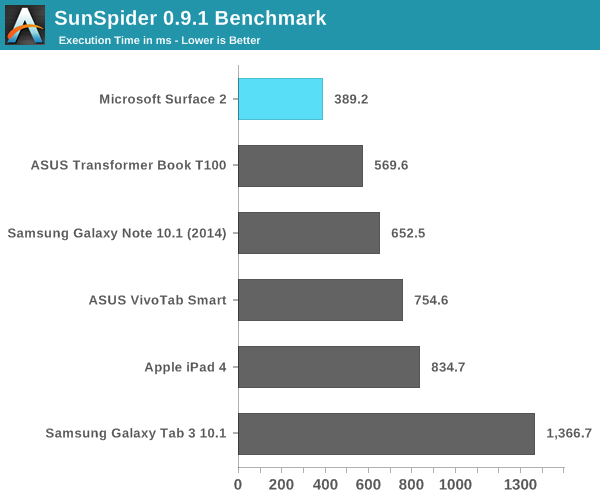
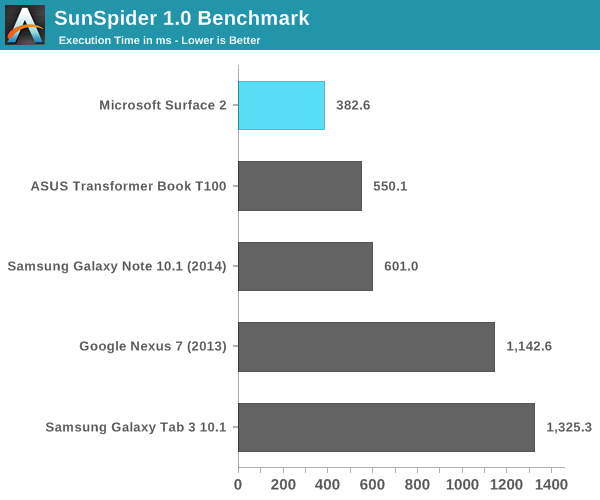
Tegra 4 running IE11 posts a better SunSpider score than even the A7 based iPhone 5s. Looking at the rest of the tests it’s very clear that SunSpider was an optimization target for Microsoft, as we don’t see this sort of performance leadership repeated anywhere else.
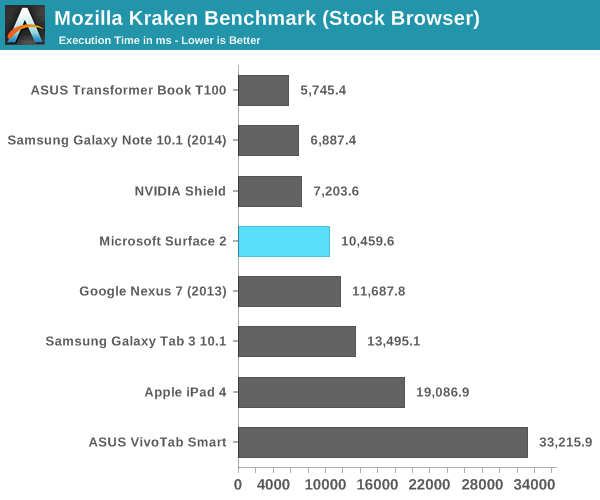
The Kraken results look decent but clearly behind high-end Android devices running Chrome. This is a huge improvement over where Microsoft was last year with Surface RT. Surface 2 can now complete the Kraken test in roughly 1/5 of the time it took Surface 1/RT to do the same work at launch. Obviously we’re seeing the benefits of IE11 in addition to Windows RT 8.1 being better optimized for ARM architectures (as well as a faster SoC), but the new tablet is just significantly faster than its predecessor.

Browsermark 2.0 gives us a good idea of where Surface 2 falls in terms of overall browsing performance. In general we’re dealing with a platform that is roughly comparable in performance to modern Android devices, but it’s not pushing the limits of performance in any way.

Google’s Octane test is obviously best optimized for Chrome, and here we see solid performance although clearly behind the fastest Android and Bay Trail devices.
GPU Performance
All of the Windows RT devices that launched last year had pretty terrible GPU performance. It didn’t matter if you had something with NVIDIA or Qualcomm inside, GPU performance wasn’t great at all. Even Intel’s competing Clover Trail solution was a huge let down on the GPU front. Clover Trail was so bad that I even noticed differences in animation frame rate between the Atom Z2560 and Qualcomm’s APQ8060A running Windows RT.
Tegra 4’s GPU on the other hand seems well suited for the task at hand. I doubt many users will be playing 3D games on Surface 2, but GPU performance is improved substantially over its predecessor. In the grand scheme of things we’re talking about roughly iPad 4 class GPU performance, all while driving a lower resolution screen.
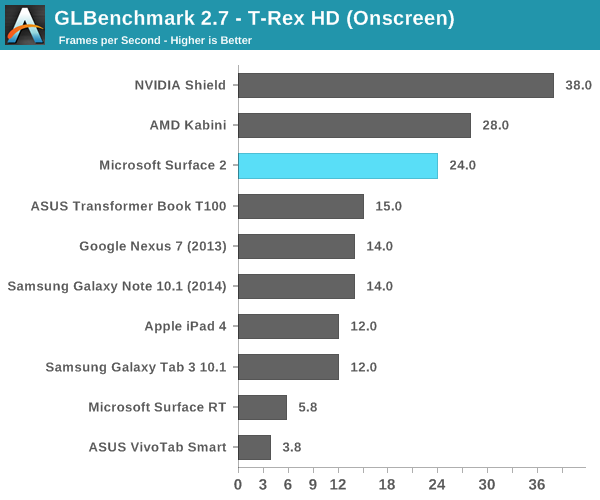
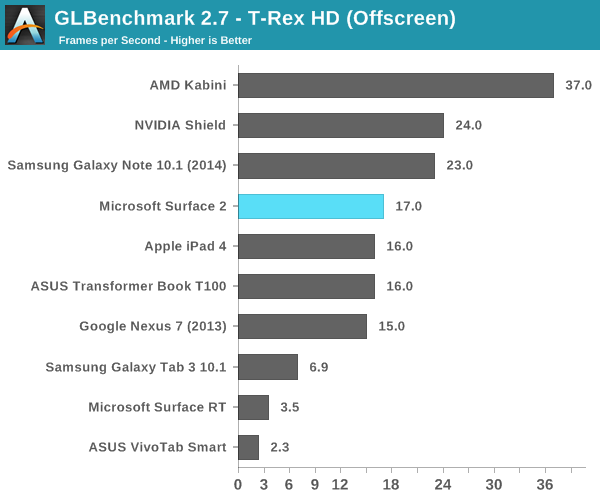
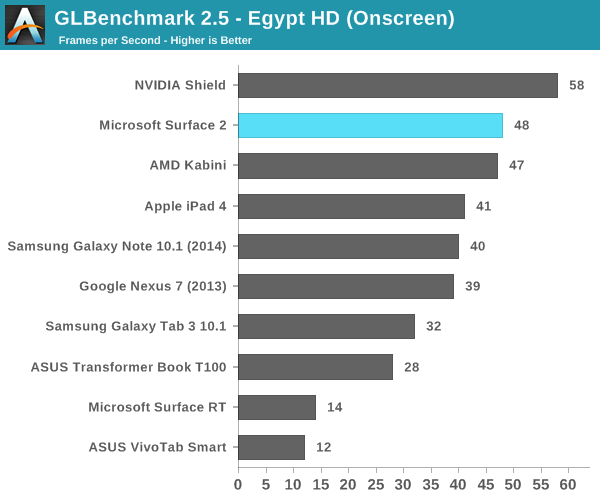
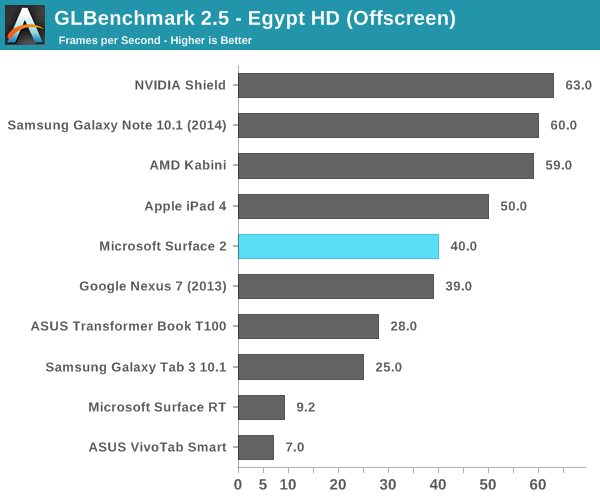



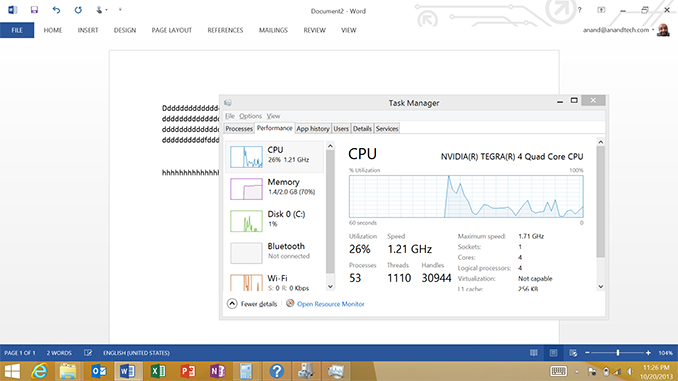








139 Comments
View All Comments
trip1ex - Monday, October 21, 2013 - link
Eh I don't see people clamoring for small tablet screen with a mediocre keyboard just so they can use Office. I don't see people wanting Windows on their tablet either. They want to ditch Windows as much they want to ditch the cable company.I think tablets are misunderstood my most still.
kyuu - Monday, October 21, 2013 - link
You're right: tablets are misunderstood by most. Apple and Google have fooled people into thinking tablets should be oversized smartphones. Microsoft instead presents WinRT, which offers much more functionality than iOS or Android, and all people can focus on is the app store selection, which is the one and only point iOS and Android have over WinRT.DocForker - Monday, October 21, 2013 - link
I love my gen 1 surface RT with 8.1 and can't wait for the Surface 2! I run apps side by side - the new Facebook is great, or I can have twitter in one panel and browse the web in the other half. OneNote that syncs between my phone, my wifes phone and my surface and my home and work desktops is amazing. Being able to edit a Word doc on my desk and then have it show up immediately in my recent list of Office Docs on the surface is awesome. Sending YouTube video (or streaming audio) from an IE browser window (using the devices charm) to my XBOX and having it play full screen high definition on my 60" plasma - all while browsing Facebook or reading the news and tracking Twitter is just something I don't think you can do anyplace else. What about playing Halo Spartan Assault on the surface and then sending it to the TV - and hooking up an XBOX controller and a Bluetooth headset. Or hooking up an external monitor with Word & Excel running on it - giving that to a person with wireless keyboard & mouse to work homework on and then having a second person playing a touch game wordament on the surface itself? Try that on an iPad or Chromebook or android tablet.I think the problems with most of these reviewers is that they just don't know what these devices are capable of. They are so locked in to a restrictive IOS ecosystem that they fail to see the possibilities with these Surface tablets.
http://s188.photobucket.com/albums/z258/tlforker/?...
http://s188.photobucket.com/albums/z258/tlforker/?...
InspectHerGadget - Tuesday, October 22, 2013 - link
You hit the nail on the head but then the restrictive iOS system does all they want so obviously they're not going out to buy an XBOX, a Windows 8 Desktop, a Windows 8 Phone then a Surface and then learn to tie it all together when they probably have AppleTV, iPad, iPhone and possibly a Mac in the house. Once you get into an ecosystem then I would say it really doesn't matter which one it is. iOS has a huge head start in this area so Microsoft have to pull out the stops to catch up and it isn't easy to get people to switch if they're happy with what they've got.ElBurro - Monday, October 21, 2013 - link
"but there’s still no good Twitter client, no amazing IM client, and of course you don’t get good integration of Google services anywhere (outside of leveraging Mail for Gmail access)."I hope you realize that in Microsoft is trying to eliminate the desktop especially for ARM. There is not much chance of the Win32 API opening up. In fact for it maybe shut down completely for Windows 10 or Windows 11 even for the pro versions of the OS.
ElBurro - Monday, October 21, 2013 - link
oops sorry I meant to put this quote"but I can’t see a future where Windows RT is successful and Microsoft doesn’t allow developers to access both sides of the platform
Death666Angel - Tuesday, October 22, 2013 - link
"It wasn’t too long ago that Microsoft was charging hundreds of dollars for new OS revisions, but with Apple and Google redefining what users come to expect from both cost and frequency of OS updates, Microsoft had to change."Isn't 8.1 more of a service pack than a new OS revision? And MS has never charged for those.
lilmoe - Tuesday, October 22, 2013 - link
Funny how much lower fps we're getting in the offscreen tests knowing that both are rendered at 1080p... Says a lot about the reliability of that benchmark. What's that overhead from?Tarrant64 - Tuesday, October 22, 2013 - link
There were statements about a new 2nd-gen charge for the Surface 2 but I have yet to see any pictures of what those changes are. It seems everything else was covered but it was hyped briefly that it would be worth buying. I'm curious if it is, because I hate my current charger. Any chance the article(s) can be updated to show the specific changes there?bull2760 - Wednesday, October 23, 2013 - link
Just purchased my Surface 2 and LOVE IT! I did previously own the 1st gen Surface RT but I sold it on Graigs list when I saw this one being released. 2nd generation is much faster at loading everying thing. Almost as fast as you click them the office suite apps open, big difference right off the bat between the 1st gen. Now that it includes Outlook you really can't beat this device for easy travel allowing you to take your work along with you. The new back lit TYPE keyboard is awesome. Way more responsive than the touch keyboard I sold with my old RT. I added a sandisk 64GB microSD and now I have 128GB of storage built in. I carry this around with me in the office as I work on employee computers so that I can answer email on the fly. Could not be happier with the purchase absolutely love the new Surface 2.